Martin Edwards's Blog, page 169
January 6, 2016
The Hypnotist - film review
The Hypnotist is a 1957 British film, which in the US was given the title Scotland Yard Dragnet. I don't think The Hypnotist is an ideal title, but the American alternative is terrible. Thankfully, the film itself is pretty good. It doesn't seem excessively stagey, even though it was based on a play by Falkland Cary, who apparently was an obstetrician before he turned to delivering work for the theatre.
Paul Carpenter plays Valentine Neal, who is involved in a flying accident and suffers an inexplicable psychological trauma as a result. His fiancee, Patricia Roc (who was a very celebrated actress in her day) finds the medics stumped by his condition, so she seeks help from a family friend, Dr Pelham (Roland Culver) who is an expert on getting to the root of psychological problems.
The murder mystery that develops from there is straightfoward in some respects,but I felt that the director, Montgomery Tully, made pretty good use of the material. Admittedly, an interlude in which our hero loses his memory and gets involved with a pretty girl he meets in a jazz club seemed more like a commercial for Chris Barber's Jazz Band than something that contributed to the plot, but the story held my attention better than many with a much bigger budget.
In researching the film, I found that Carpenter, sadly, died quite young and in rather tragic circumstances. On this evidence, he wasn't a top-notch actor, but I see that he took a lead role in a film of Julian Symons' The Narrowing Circle - a book that I didn't know had been filmed. Sadly, no DVD appears to be available. I assume it sank without trace, but if anyone knows anything about it, do please let me know.
One actor I did recognise was William Hartnell, who played the Scotland Yard cop in his customary grumpy manner. A few years later, of course, he would achieve a kind of immortality by becoming the very first Doctor Who.
Paul Carpenter plays Valentine Neal, who is involved in a flying accident and suffers an inexplicable psychological trauma as a result. His fiancee, Patricia Roc (who was a very celebrated actress in her day) finds the medics stumped by his condition, so she seeks help from a family friend, Dr Pelham (Roland Culver) who is an expert on getting to the root of psychological problems.
The murder mystery that develops from there is straightfoward in some respects,but I felt that the director, Montgomery Tully, made pretty good use of the material. Admittedly, an interlude in which our hero loses his memory and gets involved with a pretty girl he meets in a jazz club seemed more like a commercial for Chris Barber's Jazz Band than something that contributed to the plot, but the story held my attention better than many with a much bigger budget.
In researching the film, I found that Carpenter, sadly, died quite young and in rather tragic circumstances. On this evidence, he wasn't a top-notch actor, but I see that he took a lead role in a film of Julian Symons' The Narrowing Circle - a book that I didn't know had been filmed. Sadly, no DVD appears to be available. I assume it sank without trace, but if anyone knows anything about it, do please let me know.
One actor I did recognise was William Hartnell, who played the Scotland Yard cop in his customary grumpy manner. A few years later, of course, he would achieve a kind of immortality by becoming the very first Doctor Who.
Published on January 06, 2016 05:14
January 4, 2016
Simon Brett
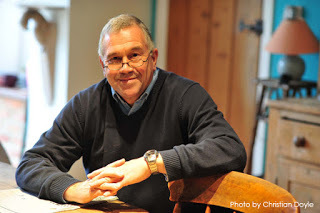
Simon Brett was awarded the OBE in the New Year's Honours for services to literature, the latest honour in a career that has been as busy as it has been distinguished. Only last year, he received the highest award in British crime writing, the CWA Diamond Dagger, recognising a career of sustained achievement.
Simon was educated at Dulwich College (as were such other writers as A.E.W. Mason, P.G. Wodehouse, and, improbably, Raymond Chandler) and Oxford, and after that he enjoyed success as a radio producer with the BBC and also as a writer for radio. His series After Henry transferred successfully to television. At its peak, the show attracted over 14 million viewers, a figure that would be beyond the dreams of TV writers today.
His first detective novel, the splendidly titled Cast in Order of Disappearance, was published as long ago as 1975 (he was very young when he wrote it!) and introduced Charles Paris, the actor and amateur sleuth who is perhaps his best loved character. He's now been responsible for no fewer than four distinct crime series. I'm also a fan of his stand-along novels, such as A Shock to the System, which was filmed with Michael Caine in the lead role, and Dead Romantic.
Simon is a witty and popular speaker. I first heard him speak at a writers' circle seminar in Southport in the late 80s, before I'd published a word of crime fiction, and I was too bashful to introduce myself. Little did I imagine that one day - it was last June - he and I would be chatting together on stage at the British Library, where he gave a terrific reading of "Agatha Christie's will", He's been an excellent President of the Detection Club for the past fourteen years - the toughest of acts to follow, it has to be said - and has masterminded the Club's round-robin novel The Sinking Admiral. His many friends and fans will be delighted by this latest recognition of his accomplishments.
Published on January 04, 2016 03:18
January 1, 2016
Forgotten Book - Death in the Dusk
Just a year has passed since we lost Bob Adey, the world's leading authority on locked room mysteries and, more importantly, a lovely man. I thought that I'd remember Bob by focusing, today, and occasionally in the future, on a handful of books from his fantastic collection that I have been able to acquire from his estate. The first, unquestionably a Forgotten Book, is Death in the Dusk by Virgil Markham.
This copy is a terrific one, because it's personally, and very nicely, inscribed by Markham: "For Winnie, who was in at the death". Someone, possibly Bob, has marked the book faintly in pencil to the effect that Winnie was the author's lover. I don't know about that, and I've no idea who Winnie was, but it's a great inscription, and a fascinating book.
Talk about Grand Guignol! This novel is typical of so many Golden Age mysteries in that it was written by a young author who was full of zest. Markham was still in his twenties when he wrote it, and you can tell - because of the exuberance and the energy of the story-telling,as well as in a degree of naivete in terms of over-writing. This is not so much a locked room mystery as a story overloaded with apparent impossibilities, as Markahm piles on the atmospherics so heavily that it makes early John Dickson Carr look positively sedate by comparison.
Victor Bannerlee is an antiquary travelling in Radnorshire, Wales. Markham was American, but like Carr, he was evidently fond of Britain, and he captures the land of legend very well. After a couple of bizarre encounters, he finds himself lost in the fog, and stumbles on an ancient mansion, which just happens to belong to an acquaintance. The house party gathered there, for a wedding, is a motley crew, and the sense of impending doom intensifies with the appearance of a bizarre apparition rejoicing in the name Parson Lolly. The area is steeped in spooky mythology, and a non-stop sequence variety of weird occurrences. There's a splendid plot twist, and I admired the way that Markham disguised it. Over-the-top, yes; verbose, definitely; but great fun
This copy is a terrific one, because it's personally, and very nicely, inscribed by Markham: "For Winnie, who was in at the death". Someone, possibly Bob, has marked the book faintly in pencil to the effect that Winnie was the author's lover. I don't know about that, and I've no idea who Winnie was, but it's a great inscription, and a fascinating book.
Talk about Grand Guignol! This novel is typical of so many Golden Age mysteries in that it was written by a young author who was full of zest. Markham was still in his twenties when he wrote it, and you can tell - because of the exuberance and the energy of the story-telling,as well as in a degree of naivete in terms of over-writing. This is not so much a locked room mystery as a story overloaded with apparent impossibilities, as Markahm piles on the atmospherics so heavily that it makes early John Dickson Carr look positively sedate by comparison.
Victor Bannerlee is an antiquary travelling in Radnorshire, Wales. Markham was American, but like Carr, he was evidently fond of Britain, and he captures the land of legend very well. After a couple of bizarre encounters, he finds himself lost in the fog, and stumbles on an ancient mansion, which just happens to belong to an acquaintance. The house party gathered there, for a wedding, is a motley crew, and the sense of impending doom intensifies with the appearance of a bizarre apparition rejoicing in the name Parson Lolly. The area is steeped in spooky mythology, and a non-stop sequence variety of weird occurrences. There's a splendid plot twist, and I admired the way that Markham disguised it. Over-the-top, yes; verbose, definitely; but great fun
Published on January 01, 2016 11:33
Happy New Year!
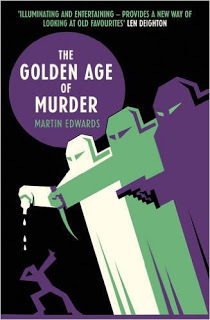
I'd like to wish all readers of my blog and my books a very happy - and healthy - 2016. Let's hope it's a year when good things far outweigh the bad. To get myself in the right sort of mood, I've already typed "Chapter One " today - the chapter heading rather than the whole chapter, I hasten to add! As well as managing to start the year without the faintest hint of a hangover, I've also been delighted to find The Golden Age of Murder named as book of the year on the widely read Random Jottings blog.
After a flurry of brand new books in 2015, this year will be slightly quieter for me - but the key word there is "slightly". I'm already looking forward to paperback publication of a revised edition of The Golden Age of Murder (a first draft of the proposed cover is above) and of The Dungeon House. I'm also hoping for an ebook publication of a new collection of my short stories, but this has yet to be finalised.
I'm now working on a couple of new books, but neither of these will achieve publication in 2016. However, I have also signed up with the British Library to compile no fewer than six new anthologies of classic crime stories, and three of these will appear this year. The first two will be Murder at the Manor - country house mysteries - and Serpents in Eden - countryside crimes. The third will be announced later n the year. .I've also reached agreement in principle for the British Library to publish something which, although short, is unusual and in the Golden Age vein- and, for me, rather exciting and unique. The details are being finalised, and I hope to say more about this before long.
Harper Collins will publish The Sinking Admiral by "certain members of the Detection Club", including me. This collaborative novel, supervised by Simon Brett, has proved very enjoyable to create and it will also give a welcome boost to the Club's coffers. There may also be a further Detection Club project later in the year, if all goes according to plan.
I've already written intros for a host of new entries in the British Library Crime Classics series, and there are some very good books to look our for. There will also be a reissue in the Collins Detective Story Club of an old Edgar Wallace for which I've written an intro.
I'm hoping that this year will see the publication of Taking Detective Stories Seriously, the collected Sunday Times crime reviews of Dorothy L. Sayers, for which I've written a detailed commentary. The Dorothy L. Sayers Society is publishing this, and I must say the reviews are a mine of information. They are also very enjoyably written.
It's going to be a busy year in terms of festivals - Crimefest, Malice Domestic, St Hilda's, The Bodies in the Library, Deal Noir, Essex Book Festival and Felixstowe Book Festival are already in the diary. I hope very much to meet some of you at one or another of those events. Last year, this blog sailed past the million pageview milestone, and your comments and emails continue to give me enormous pleasure - I'm truly grateful for your support. Writing is satisfying in itself, even if what one writes never sees the light of day, but there's something special about writing something that appeals to discerning readers.
Published on January 01, 2016 06:07
December 31, 2015
2015: The Publications
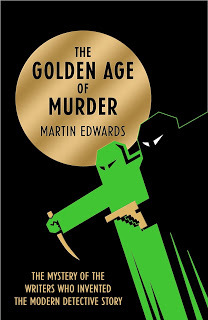
In 2015, I published a non-fiction book, a novel, four anthologies and three short stories, as well as introducing a raft of classic crime novels. Quite a year, then. But of course, the appearance of so many books so quickly is partly due to coincidence. I've been working on one of them in particular for a very long time. In May, The Golden Age of Murder, the product of so many years of reading and research (and indeed writing) finally made an appearance. I'd spent most of those years expecting it would be published by a small press, and reaching a modest readership. It felt like a niche project, not exactly self-indulgent,,perhaps, but not like a book of mass appeal. Yet it has proved, in terms of hardback sales and the number and quality of reviews, to be the most successful book I've ever written. I never anticipated this, but I'm very, very happy about it.
I've tried to analyse why it's happened, and the reviews (nearly one hundred of them now: incredible) do supply a few clues. I suppose the answer is something to do with a revival of interest in classic crime, and something to do with the fact that, whatever else may be said about it, The Golden Age of Murder is an unusual and idiosyncratic book. Yes, it's non-fiction, but there is a lot of me (or rather, what fascinates me) in it, and this has proved to be less of a disadvantage than I might have thought. What I'm really pleased about is the breadth of the book's appeal - not just to died-in-the-wool Golden Age fans, but all sorts of readers and reviewers, and indeed a surprising number of contemporary writers, some of whom have been so kind as to send me personal messages which usually include the phrase "I never knew that..."
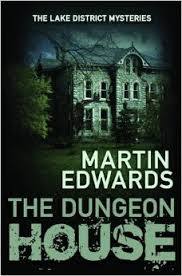
The Dungeon House, sixth of the Lake District Mysteries, appeared more recently, and I've been gladdened by two things. First, readers have responded well to the fact that this novel differs in some ways from earlier entries in the series. Second, my fiction seems to be reaching a wider audience than in the past. This was helped the other day by a Kindle Daily Deal on three books in the series, which saw them briefly occupying places in the top 15 Kindle bestsellers list. I'm accustomed to my novels not selling in vast numbers (to put it mildly), but things definitely seem to be moving in the right direction.
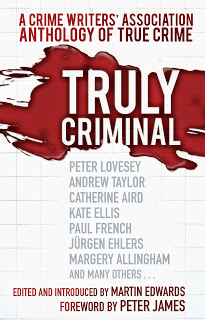
For the CWA, I put together an anthology of essays about real life crimes, Truly Criminal, published by the History Press. In comparison to my other books this year, it hasn't received widespread attention, or achieved large sales, but I feel that the quality of the contributions (three of them written by winners of the CWA Diamond Dagger) deserves to ensure its longevity. Nothing very like it has been produced for many years, and I'm hopeful that it's a book whose reputation will keep growing..
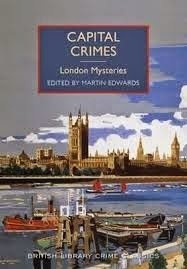
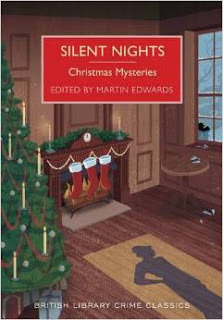
As well as introducing classic crime books published by the British Library, I've contributed intros to the welcome reprint of Hugh Conway's Called Back and also to a second Arcturus anthology of Sherlock Holmes stories. For the BL I've also edited three anthologies of short stories. Both Capital Crimes and Resorting to Murder outsold any of the other anthologies I've edited - by a long way - and recently Silent Nights has become one of the most successful titles in the series. It seems already to be one of the bestselling crime anthologies published in Britain in recent decades..Something else my crystal ball never foretold...
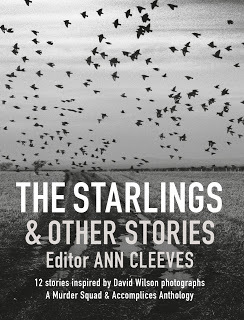
On the short story front, I was glad to contribute to Murder Squad's Starlings (a story that was barely criminous, and influenced by my love of the work of Robert Aickman) and Maxim Jakubowski's anthologies of stories about Professor Moriarty and Jack the Ripper respectively.
So what does next year have in store? If you'd like to know, take a look at the blog tomorrow...
Published on December 31, 2015 07:14
December 30, 2015
2015: The Places
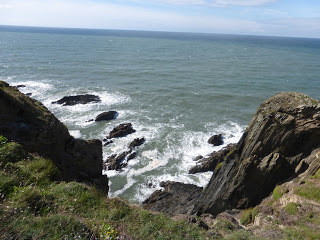

This past twelve months, I've visited a wonderful variety of places, near to home, and very remote, and many have had literary associations., For many years, I hardly travelled abroad, but I've more than made up for that in recent times. It remains the case, however, that I love Britain, and exploring places that are relatively close at hand. A prime example came with a trip to Burgh Island in September. It was great fun to follow in Agatha Christie's footsteps: Burgh is not only the place that inspired the setting for Evil under the Sun, and probably also And Then There Were None, but a magical spot in its own right. The fact that my visit coincided with warnings of a tropical storm which cut us off from the mainland only added to the atmosphere...
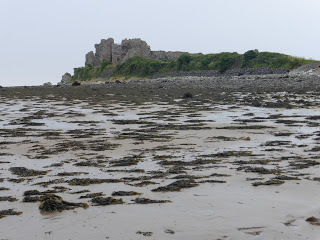

You could say something similar about Piel Island (above), off the Cumbrian coast. No murder story has yet been set there - but the operational word there is 'yet'...A boat trip out there, courtesy of the King of Piel, was a great experience. Again there was a risk of being stranded on the island, but this time it didn't materialise. I went to Piel as part of my Lake District research for the next book. Other destinations included Silloth, visited on a beautiful afternoon, with great views over the Solway Firth, and that's another location I mean to use in fiction before long.
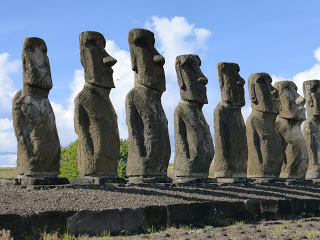
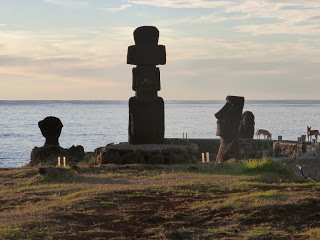
In fact, travel is, I find, a great way of getting story ideas. I suppose it's because of the exposure to a wider range of ways of life. I don't actually do any writing whilst on my travels. Rather, I take notes of all manner of things that strike me as interesting. This year there was an island theme to many of my trips. The most amazing destination was Easter Island, somewhere I've been fascinated about since I read Thor Heyerdahl's Aku Aku as a young boy. Heyerdahl's theories about the islanders' origins are now outdated, but his book fired my interest in the unique history of Rapa Nui. There's always a danger that some destinations may not live up to expectations, but that was never a possibility with this wonderful place.






The journey was so long that the travel agent persuaded me that it made sense to combine it with a look at South America. Good advice - I'd never had such a burning desire to visit Chile or Peru, but they turned out to be marvellous destinations. Not just Machu Picchu, but also places like Cuzco, Valparaiso and the Atacama Desert. Unforgettable. And two of them are likely to feature in my fiction before long. Whilst in Valparaiso, I visited the home of Pablo Neruda, and was delighted to discover in his personal library copies of a stack of Golden Age paperbacks - including Trial and Error by Anthony Berkeley, and titles by the likes of Michael Innes and Q. Patrick.



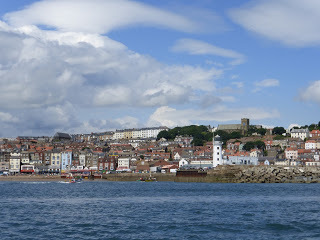
A week's cruise around islands of the West Indies was a more recent treat. Pick of the bunch was Bequia in the Grenadines, closely followed by St Lucia. but each island has its own distinctive nature and plenty to offer. Dominica is an example. It was the birthplace of the late Jean Rhys, and I've just finished reading The Wide Sargasso Sea, which was a Christmas present (yep, I do sometimes get away from crime fiction, believe it or not!) I'd not read Rhys before, but hers was an extraordinary life, and there is something quite compelling about her prose. This book is regarded as her masterpiece, but I'm certainly tempted to read more of her work.
Somehow this year I managed to spend my birthday sailing on a pirate ship in the harbour of Scarborough, North Yorkshire (last of the above photos), and then, four month later, travel to another port called Scarborough - in Tobago (next to last photo). No prizes for guessing which was slightly warmer, but the Yorkshire resort will always be one of my favourites: it has rather more to offer than endless sunshine..

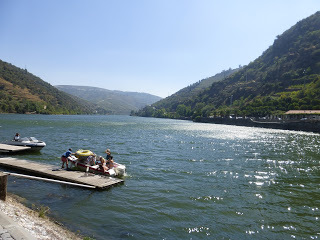

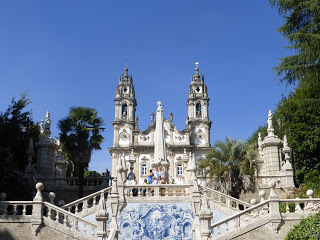

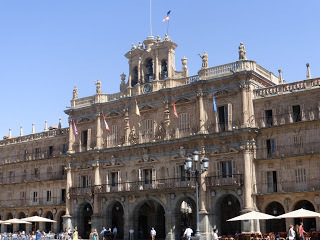
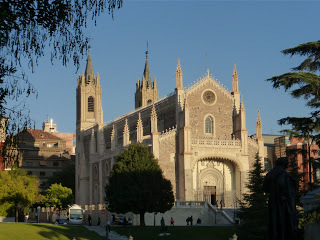

Back in Europe, I managed to see plenty of new places, including Sintra, Porto, Coimbra, Lamego, and the fabulous River Douro in Portugal, Salamanca, Madrid and Toledo in Spain, and the charming and under-estimated Ghent.

I travelled to Ghent by Eurostar, something made easier by the location of my son's flat within walking distance of St Pancras. I've spent much more time in London (below photo) than before, and this has given me a chance not only to meet up with more people, but also to see some of the never-ending exhibitions, including the Magna Carta exhibition at the British Library, and the intriguing cartoons at the Cartoon Museum, as well as places like Tate Modern and the NPG. The recent Alice in Wonderland exhibition at the BL was definitely worth a look. I'm an Alice fan, and Daresbury, where Lewis Carroll spent much of his early life (hence the 'Cheshire Cat') is just down the road from where I live.
It's impossible to do everything that one would like to do in life. One can't read every book, or visit every resort. All the same, I've been lucky this past twelve months to have had the good health and the time to see at least some of the marvellous places the world has to offer..
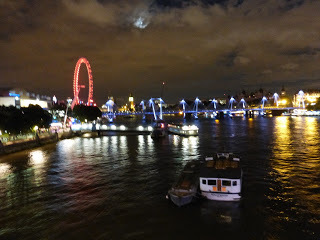
.
Published on December 30, 2015 05:30
December 29, 2015
2015 - The People
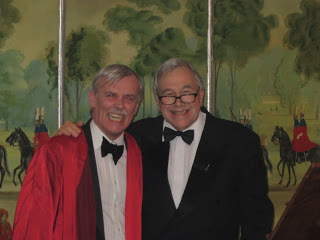
A crime writing friend sent me an email the other day in which she said that 2015 had, for me, been something of an annus mirabilis. Shortly afterwards, a second email from another friend said exactly the same thing. Well, each year has its ups and downs, but they are right; I'll be very lucky indeed if any other twelve month period matches this one for pleasurable experiences. Over the next three days I'll reflect on the people, places and publications that have made this year such a special one for me, and it seems right to start with what always matters most - people.
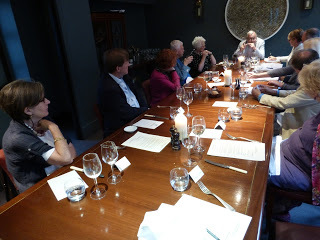
In 2015, I was doubly honoured. Members of the Detection Club elected me as their President, and I owe them a great debt. Above all, I'm grateful to Simon Brett, the outgoing President, who has given me tremendous support. My number one aim is to make sure that the Club continues to flourish, and I have plenty of ideas about how to achieve that. One great pleasure has been taking part in meetings with those Club members who have been co-writing The Sinking Admiral, due to be published next year. Most of the meetings took place in London hostelries, but Simon also organised an unforgettable Whodunit Dinner at the Groucho Club (above photo) when we figured out the solution to our own mystery.
This year I was also elected Vice Chair of the Crime Writers' Association, during an excellent conference in Lincoln. Among those present at Lincoln was Tim Heald, who unfortunately is in very poor health these days. I asked if he thought he'd be able to make it to the Detection Club dinner later in the year, and he said he doubted it - but with a characteristic grin, added: "But I'll be there in spirit." He certainly was. I've enjoyed working with the excellent CWA committee led by Len Tyler - who happens to be one of the contributors to The Sinking Admiral.
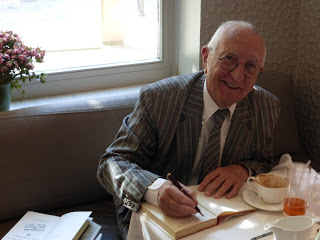
Two lunches stand out in my memory because they were spent in the company of two men I admired as a teenager and have continued to admire ever since. The legendary Len Deighton invited me to Koffman's, and treated me to three hours of fascinating anecdotes about his life and career. Incredibly kind and truly unforgettable. The photo above shows Len in the process of inscribing his first four books to me. Peter Gibbs, playwright, novelist, and former Derbyshire cricketer took me to Vincent's Club in Oxford, and we spent the day together, revisiting old haunts. I also had the pleasure of meeting for the first time Simon Curtis, director of My Week with Marilyn, who invited me for coffee at the Ivy Club - my first visit there - and a chat about Golden Age books..

I work with several lovely publishers, and two of my editors, David Brawn of Harper Collins, and Rob Davies of the British Library, took part in the Bodies in the Library conference in June. Jake Kerridge interviewed me about the Golden Age, and Simon and I talked about the Detection Club. The event provided a great opportunity to meet several readers of this blog for the very first time, something I really enjoyed. There are many other readers whom I only know through comments and emails, but I hope that in the coming year, I'll have the chance to get to meet more of you in person.
I took part in panels at Crimefest and the Harrogate Festival alongside such luminaries as Andrew Taylor, John Harvey, Peter James, and Peter Swanson, and got to hang out with some delightful folk, including James Runcie, whose Grantchester novels have been such a hit. The photo above is of a memorable dinner with Catherine Aird, who won this year's CWA Diamond Dagger.
Malice Domestic in Washington DC was terrific. I interviewed Ann Cleeves, the international guest of honour, appeared on a Golden Age panel moderated by Doug Greene, and generally had a great time. All being well, I'll be back there in 2016. I also took part in crime festivals closer to home, in Liverpool, Northwich, and Knutsford, as well as those in Carlisle and Torquay, the latter for the Agatha Christie Festival. I appeared on Sunday Brunch, Radio 4's Open Book and (believe it or not) a Japanese documentary about Agatha Christie, as well as having the pleasure of watching my Harry Devlin books feature on BBC's Mastermind.
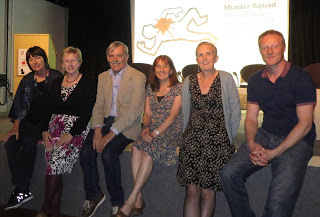
Murder Squad continues to thrive, and we got together at Carlisle in the early summer (above photo) before launching our collection of stories, Starlings, which is edited by Ann, in Wrexham. Mrs Edwards contributed a story to that book and I hope she can be tempted to do more writing next year. The fact that I'm now only a part-time lawyer also gave me the chance to catch up with some mates from university and school days as well as some much newer friends.
I met - at long last - Roberto and Davide, two Italians with whom I've been in touch for many years, at the Burt Bacharach concert at the Royal Festival Hall in summer (photos below), found that the former owners of my son's London flat, Elaine and English Showalter, are not only distinguished academics but charming dinner companions, and over a pint in a London bar I learned a bit about Austrian academe from a professor I'd first met on a trip around Easter Island, It's always easy to put this kind of socialising with civilised companions off to some unspecified date in the future - but it's so much more enjoyable if you don't. None of us know what is round the corner. Might as well make the most of life right now.
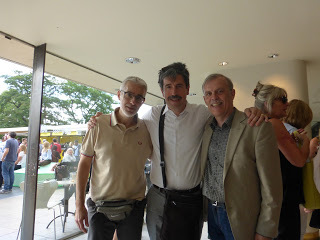

Published on December 29, 2015 06:04
December 26, 2015
And Then There Were None - BBC 1 TV review

And Then There Were None is the finest of all Golden Age detective stories in my opinion- never mind that it lacks a great detective in the mould of Poirot or Marple. Agatha Christie wrote plenty of fine crime stories, but this has been my favourite since I first read it at a tender age. So the question I asked myself when anticipating this evening's first episode of the BBC TV three-part adaptation by Sarah Phelps was - would the TV version do the book justice?
There's been a lot of cunningly contrived publicity in the run-up to this showing which has been designed to generate interest. It has been suggested that Phelps was modernising the story in an inappropriate way, by introducing drug-taking, bad language, and other terribly topical features. Phelps, we were told, had never read any Christie before taking on the task of writing the script. I was rather sceptical about whether the script would prove as shocking as was implied. If you've ever read much Agatha Christie, you will know, for instance, that drug-taking crops up in a good many of her stories. And I devoted a good slice of The Golden Age of Murder to explaining why the perception that Christie's work is "cosy" is feebly inadequate.
The early scenes, which set up the complex mystery, were well done, I thought. This was probably where a less accomplished screenwriter would have found it easiest to mess up. The book supplies plot, dialogue and characters aplenty, but the challenge of creating the right mood at the outset was an important test, and I felt Phelps passed it with flying colours.From then on, the excellent cast, did the work of keeping me glued to the screen. The filming hasn't been done, as far as I can tell, on Christie's beloved Burgh Island, but I kept thinking back to my own trip to Burgh in September, and my brief experience of being cut off from the mainland for a while, due to the heavy seas....
Phelps has quite an interesting approach to pacing the plot developments, and as I'm starting to study the art of scriptwriting myself, it's helpful to see how an expert does it. Charles Dance, Miranda Richardson, Aidan Turner and Maeve Dermody (who was excellent in the key role of Vera) were all particularly good, while Noah Taylor and Anna Maxwell Martin made splendidly creepy servants. Two members of the cast have met untimely ends so far. The body count will continue to mount tomorrow night. And I will definitely be watching.
Published on December 26, 2015 14:38
December 24, 2015
Forgotten Book - Mr Bowling Buys a Newspaper
In my last post before Christmas, I'd like to wish all readers of this blog a very happy and peaceful time over the festive season. Thanks for all your feedback; it's always good to hear from you, and I've learned a lot from people who have taken the trouble to get in touch. Today's blog is a case in point, as a correspondent has greatly increased my knowledge and understanding of a writer who has long intrigued me.
Donald Henderson died young in 1947, just three years after the publication of Mr Bowling Buys a Newspaper. It's his most famous book, thanks to words of admiration from Raymond Chandler, which prompted me to search it out many moons ago. I re-read it recently, and for me, it has much the same darkness as Patrick Hamilton's better-known Hangover Square, but it's nevertheless distinctive. Sensibly, Henderson kept the book short - a greater contrast from Georgette Heyer's over-long Penhallow, discussed here yesterday, would be hard to imagine.
We know from the outset that William Bowling, public school educated and superficially charming, is a murderer. Henderson conveys with economy and skill a rather complex psychological profile, and we follow Bowling as he moves from one more or less motiveless crime to another. It makes for chilling and compelling reading. Very different from Chandler's style, but you can see why the great man was taken with it.
The title, seemingly innocuous, is rather creepy. Mr Bowling buys the newspapers only to find out what the latest is on the murder he's committed. He is skilled in getting away with murder without really trying. This is a dark and ironic book, and there are echoes of Francis Iles as well as of Hamilton. I don't claim that Henderson was as good a writer as that pair, but perhaps had he lived longer, he would have achieved a great deal more.
Henderson was an interesting chap, and I'm indebted to Paul T. Harding, who has researched his life over a good many years, and presented his archive to the University of Reading, for giving me fresh information about him, as well as the chance to read autobiographical material that has aided my understanding of him as a writer. Henderson's other major book is Goodbye to Murder, which was published in a Pan paperback edition, but his earlier crime novels, such as Murder at Large, are very obscure. Both Paul and I hope to have more to say about Henderson in the future.
Donald Henderson died young in 1947, just three years after the publication of Mr Bowling Buys a Newspaper. It's his most famous book, thanks to words of admiration from Raymond Chandler, which prompted me to search it out many moons ago. I re-read it recently, and for me, it has much the same darkness as Patrick Hamilton's better-known Hangover Square, but it's nevertheless distinctive. Sensibly, Henderson kept the book short - a greater contrast from Georgette Heyer's over-long Penhallow, discussed here yesterday, would be hard to imagine.
We know from the outset that William Bowling, public school educated and superficially charming, is a murderer. Henderson conveys with economy and skill a rather complex psychological profile, and we follow Bowling as he moves from one more or less motiveless crime to another. It makes for chilling and compelling reading. Very different from Chandler's style, but you can see why the great man was taken with it.
The title, seemingly innocuous, is rather creepy. Mr Bowling buys the newspapers only to find out what the latest is on the murder he's committed. He is skilled in getting away with murder without really trying. This is a dark and ironic book, and there are echoes of Francis Iles as well as of Hamilton. I don't claim that Henderson was as good a writer as that pair, but perhaps had he lived longer, he would have achieved a great deal more.
Henderson was an interesting chap, and I'm indebted to Paul T. Harding, who has researched his life over a good many years, and presented his archive to the University of Reading, for giving me fresh information about him, as well as the chance to read autobiographical material that has aided my understanding of him as a writer. Henderson's other major book is Goodbye to Murder, which was published in a Pan paperback edition, but his earlier crime novels, such as Murder at Large, are very obscure. Both Paul and I hope to have more to say about Henderson in the future.
Published on December 24, 2015 03:59
December 23, 2015
Forgotten Book - Penhallow
There are two writers, long popular with many readers, for whose mystery novels I have always had a blind spot. One is Patricia Wentworth, the other is Georgette Heyer. I can't summon up much enthusiasm for Wentworth's Miss Silver, I'm sorry to say,, and I've stared Heyer novels more than once, only to give up at an early stage. But several people whose judgement I respect rate both these writers highly. I therefore resolved to try again, and so I read Heyer's Penhallow from start to finish.
It's a country house story. Old man Penhallow rules his family with a rod of iron, and what is worse,his extravagance means that the estate risks running out of money. He's a nasty piece of work, the old chap, someone who takes pleasure in hurting people, not least his much younger wife. He likes having staff and family members at his beck and call. A character who rejoices in the name of Jimmy the Bastard is both a servant and an illegitimate child; and it turns out that Jimmy is not the only person in the family whose lack of legitimacy means he has no claim on the estate when the old tyrant's life finally (and very belatedly) comes to an end.
Heyer was a very competent writer, who retains a following, mostly for her historical romances, but also for her forays into crime. She was never much interested in the plotting of a mystery - a task generally delegated to her husband, it seems. On this occasion, he did not bother to come up with any sort of puzzle - this is one of the least mysterious of books, and the detective work is perfunctory in the extreme. .
Every now and then, a member of the family tells the others how loathsome they all are, and each time I found myself agreeing. The awfulness of Penhallow and his tribe is established early on, but this doesn't stop Heyer spending another 400 pages or so ramming home the message. To me, it felt like a wearisome, never-ending soap opera, going on and on and on and on. There's an explanation for this, according to some sources, who suggest that Heyer wrote the book with a view to escaping from her contract with her then publishers. Yet her biographer, Jennifer Kloester, provides a rather more nuanced account of the writing of the book,which indicates that Heyer was actually pretty happy with it. For the time being at least, however, she remains one of my crime fiction blind spots..
It's a country house story. Old man Penhallow rules his family with a rod of iron, and what is worse,his extravagance means that the estate risks running out of money. He's a nasty piece of work, the old chap, someone who takes pleasure in hurting people, not least his much younger wife. He likes having staff and family members at his beck and call. A character who rejoices in the name of Jimmy the Bastard is both a servant and an illegitimate child; and it turns out that Jimmy is not the only person in the family whose lack of legitimacy means he has no claim on the estate when the old tyrant's life finally (and very belatedly) comes to an end.
Heyer was a very competent writer, who retains a following, mostly for her historical romances, but also for her forays into crime. She was never much interested in the plotting of a mystery - a task generally delegated to her husband, it seems. On this occasion, he did not bother to come up with any sort of puzzle - this is one of the least mysterious of books, and the detective work is perfunctory in the extreme. .
Every now and then, a member of the family tells the others how loathsome they all are, and each time I found myself agreeing. The awfulness of Penhallow and his tribe is established early on, but this doesn't stop Heyer spending another 400 pages or so ramming home the message. To me, it felt like a wearisome, never-ending soap opera, going on and on and on and on. There's an explanation for this, according to some sources, who suggest that Heyer wrote the book with a view to escaping from her contract with her then publishers. Yet her biographer, Jennifer Kloester, provides a rather more nuanced account of the writing of the book,which indicates that Heyer was actually pretty happy with it. For the time being at least, however, she remains one of my crime fiction blind spots..
Published on December 23, 2015 00:41



